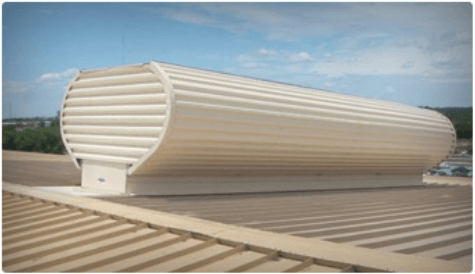Understanding Natural Ventilation’s Impact
Natural ventilation is an old technology that has returned to the limelight because of the increased focus on green construction and green energy. So, what is gravity ventilation, and what exactly is Natural Ventilation’s impact?
The Impact of Natural Ventilation
Much as the name suggests, natural ventilation is a process by which a building is kept at a comfortable temperature by using the natural flow of air. With a ventilation system that exhausts air naturally, the air leaves the building through vents in the roof and not through powered equipment.
The key to the system’s success is nature’s desire to keep equal pressure on both the inside and outside of a building. When warm air rises, new fresh air is pulled in from vents at the floor level to fill the void. In turn, the air coming in also pushes the warm air up, perpetuating the cycle or airflow. Natural ventilation’s impact on a building can be huge.
How Could Your Business Benefit from Natural Roof Ventilation?
Every type of facility can benefit from natural ventilation. While the extent of its use may depend on climate, industry, and building layout, it can usually be used in some capacity in every type of plant. Although it isn’t as useful in a break room or control booth, it is especially useful on a shop floor. Some types of facilities that can benefit from natural ventilation systems include.
- Metal foundries and mills: These industries require extremely elevated temperatures to melt and forge metals. A natural system would allow the intense heat to flow naturally upward and out of the building, creating a more comfortable temperature inside of the structure. A natural system also directs harmful fumes outside and away from employees.
- Power plants: Many electrical plants produce hot temperatures and/or fumes. A new system means a safer, more comfortable building with reduced or no cooling costs.
- Industrial and data facilities: Fumes from chemical or plastic production is both a fire and health hazard. Likewise, naturally elevated temperatures in a data facility could lead to system meltdowns. Gravity roof ventilation reduces these risks by regulating the airflow naturally, efficiently removing both excess heat and fumes from the building.
- Wood and paper plants: The predominant concerns of such facilities are heat and moisture. In addition to drawing heat out of the building, gravity ventilation creates an outlet for humidity, reducing condensation and the risk of structural corrosion or damage to the product.
Installation Considerations
There are several options for gravity ventilators. The best option is dependent upon the size and function of your building. Warehouses and other spaces with large, open areas and open spaces where mechanical ventilation systems are unnecessary or unusable are best suited for gravity roof ventilators.
A major consideration is the design of the building. Every bay, window, door, or another opening in the outer walls will affect airflow. Likewise, manufactured, and natural objects around the building may affect the air currents. The building’s orientation affects the time and scope of afternoon temperature changes. Internal obstacles, such as walls or large-scale equipment, may further hinder air circulation.
Finally, geographical location plays a key role in natural ventilation’s impact on your building. The Moffitt team designs gravity roof ventilation system specifically for each building. Building dimensions, local weather patterns, and average temperatures all play major roles in the efficiency of a natural ventilation system.

Natural Ventilation’s Impact
Moffitt designs, manufactures, and installs natural ventilation, pressure gravity ventilation, and powered ventilation systems all over the world. They use the latest in Computational Fluid Dynamics (CFD) Modeling to determine the best possible ventilation for your building. This means that your resulting ventilation system will be at peak efficiency for your building and its environs. Due to this high degree of professionalism and attention to the personal needs of every client, Moffitt has become one of the leading companies in gravity roof ventilator technology. Please contact Moffitt to learn more about natural ventilation’s impact.
